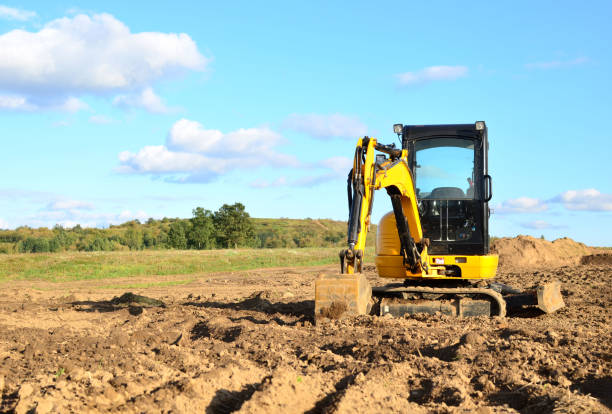Transporting a mini excavator safely requires careful planning and adherence to safety protocols to ensure that the machine, the transport vehicle, and other road users are protected. Whether you’re moving a mini excavator to a new job site or returning it after a rental period, following the correct procedures can prevent accidents and damage. This blog will guide you through the steps to transport your mini excavator safely and efficiently.
Preparing the Mini Excavator for Transport
Before transporting your mini excavator, it’s essential to prepare the machine properly. This involves securing loose parts, inspecting the excavator, and following manufacturer guidelines.
Inspect the Excavator
Conduct a thorough inspection of the mini excavator before transport. Check for any leaks, loose parts, or damages that need attention. Ensure that all fluids are at appropriate levels and that the machine is in good working condition.
- Check Fluids: Verify that hydraulic fluid, engine oil, and coolant levels are adequate.
- Inspect Tracks: Ensure that the tracks are in good condition and properly tensioned.
- Secure Attachments: Remove or securely fasten any attachments, such as buckets or augers, to prevent movement during transport.
Clean the Excavator
Clean the mini excavator to remove any dirt, debris, or mud that could fall off during transport. This not only ensures safety but also complies with regulations that prevent transporting invasive species or contaminants.
Retract the Boom and Arm
Retract the boom and arm of the mini excavator to reduce its size and lower its center of gravity. This makes the machine more stable and easier to secure on the transport vehicle.
Choosing the Right Transport Vehicle
Selecting the appropriate transport vehicle is crucial for safely moving your mini excavator. The vehicle must be capable of handling the weight and size of the excavator.
Flatbed Trailer
A flatbed trailer is a common choice for transporting mini excavators. Ensure that the trailer is rated to carry the weight of your excavator and has adequate space for securement.
- Weight Capacity: Verify that the trailer’s weight capacity exceeds the weight of the mini excavator.
- Tie-Down Points: Ensure the trailer has sufficient tie-down points to secure the excavator firmly.
Lowboy Trailer
For larger mini excavators, a lowboy trailer may be necessary. These trailers sit closer to the ground, making it easier to load and unload heavy equipment.
- Accessibility: Ensure the lowboy trailer can be easily accessed and loaded without risk.
- Stability: The lower height provides increased stability during transport.
Loading the Mini Excavator
Loading the mini excavator onto the transport vehicle requires precision and attention to detail to prevent accidents and ensure stability.
Use Loading Ramps
Use sturdy loading ramps to drive the mini excavator onto the trailer. The ramps should be rated for the weight of the excavator and securely attached to the trailer.
- Angle of Approach: Position the ramps at an angle that allows for smooth ascent without risking the excavator tipping over.
- Alignment: Align the excavator with the ramps to ensure a straight and steady approach.
Drive Slowly and Carefully
Drive the mini excavator up the ramps slowly and carefully, maintaining a steady speed. Avoid sudden movements or sharp turns that could destabilize the machine.
- Controlled Ascent: Use low gear and keep the speed consistent.
- Spotter Assistance: Have a spotter guide you during the loading process to ensure proper alignment and safety.
Position the Excavator
Position the mini excavator on the trailer, ensuring it is centered and balanced. The weight distribution should be even to prevent the trailer from tipping or swaying during transport.
Securing the Mini Excavator
Securing the mini excavator properly is vital to prevent it from shifting or falling off the transport vehicle during transit.
Use Heavy-Duty Chains and Binders
Use heavy-duty chains and binders to secure the mini excavator to the trailer. Attach the chains to the designated tie-down points on the excavator and the trailer.
- Attachment Points: Use the manufacturer-recommended tie-down points on the excavator.
- Tension: Ensure the chains are tight and the binders are secure.
Cross-Chain for Stability
Cross-chain the front and rear of the mini excavator to provide additional stability and prevent lateral movement.
- Front and Rear: Secure the front and rear of the excavator with crossed chains.
- Double-Check: Verify that all chains and binders are secure before departure.
Driving and Transporting
Once the mini excavator is securely loaded and tied down, follow safe driving practices to ensure a smooth and safe transport.
Drive Cautiously
Drive at a safe speed, especially when navigating turns or rough terrain. Sudden stops or sharp turns can cause the load to shift, leading to potential accidents.
- Speed Limit: Adhere to speed limits and adjust your speed based on road conditions.
- Smooth Driving: Avoid sudden accelerations or decelerations.
Monitor the Load
Periodically check the load during the journey to ensure the mini excavator remains secure. Pull over safely to inspect the chains and binders if you suspect any issues.
- Regular Stops: Make regular stops to inspect the load.
- Adjust as Needed: Tighten any loose chains or binders during these inspections.
Conclusion
Transporting a mini excavator safely requires careful preparation, proper equipment, and vigilant driving practices. By inspecting and preparing the excavator, choosing the right transport vehicle, securing the load correctly, and driving cautiously, you can ensure that your mini excavator arrives at its destination without incident. Following these guidelines helps protect your investment, ensures compliance with safety regulations, and promotes a smooth and efficient transportation process.









